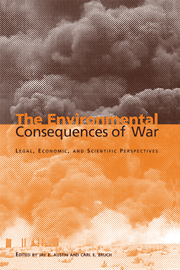Book contents
- Frontmatter
- Contents
- List of illustrations
- List of tables
- List of contributors
- Acknowledgements
- Foreword by Klaus Toepfer
- Introduction
- Part I General principles
- Part II The legal framework
- Part III Assessing the impacts – scientific methods and issues
- Part IV Valuing the impacts – economic methods and issues
- Part V Prospects for the future
- Index
Introduction
Published online by Cambridge University Press: 04 August 2010
- Frontmatter
- Contents
- List of illustrations
- List of tables
- List of contributors
- Acknowledgements
- Foreword by Klaus Toepfer
- Introduction
- Part I General principles
- Part II The legal framework
- Part III Assessing the impacts – scientific methods and issues
- Part IV Valuing the impacts – economic methods and issues
- Part V Prospects for the future
- Index
Summary
For centuries, military commanders have deliberately targeted the environment, seeking to obtain any possible advantage over their adversaries. In the Third Punic War, Roman legions salted the ground around Carthage to prevent the Carthaginians from recovering and challenging Rome; in the US Civil War, General Sherman cut a wide swath of destruction across the South in an attempt to break the morale of the Confederacy; in World War I, the British set afire Romanian oilfields to prevent the Central Powers from capturing them; in World War II, Germany and the Soviet Union engaged in “scorched earth” tactics; and in the Korean War, the United States bombed North Korean dams.
The Vietnam War showcased the increasingly devastating environmental effects of modern military technology, with entire ecosystems targeted. The United States engaged in a massive defoliation campaign to preclude the growth of groundcover, and even attempted to change weather patterns via cloud seeding over North Vietnam to hamper enemy troop movements and provide protection for US bombing missions. Since then, the public health implications of environmental warfare in Vietnam - primarily birth defects, diseases, and premature death associated with exposure to Agent Orange - have become apparent. The scale, severity, and longevity of these environmental impacts sparked the first international legal provisions specifically prohibiting environmental warfare: the 1976 Environmental Modification Convention (ENMOD) and the 1977 Additional Protocol I to the 1949 Geneva Conventions (Protocol I). Notwithstanding international condemnation of such tactics, Central American internal conflicts of the 1980s saw further use of defoliation campaigns, albeit to a lesser degree than in the Vietnam War.
- Type
- Chapter
- Information
- The Environmental Consequences of WarLegal, Economic, and Scientific Perspectives, pp. 1 - 10Publisher: Cambridge University PressPrint publication year: 2000

